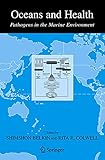Oceans and Health: Pathogens in the Marine Environment / edited by Shimshon Belkin, Rita R. Colwell.
Tipo de material: TextoEditor: Boston, MA : Springer US, 2005Descripción: XIV, 464 páginas, recurso en líneaTipo de contenido:
TextoEditor: Boston, MA : Springer US, 2005Descripción: XIV, 464 páginas, recurso en líneaTipo de contenido: - texto
- computadora
- recurso en línea
- 9780387237091
- QR100-130
Springer eBooks
Pathogens in the Sea: An Overview -- Diversity, Sources, and Detection of Human Bacterial Pathogens in the Marine Environment -- Biotic and Abiotic Effects -- Survival of Enteric Bacteria in Seawater: Molecular Aspects -- Human Pathogenic Viruses in the Marine Environment -- Survival of Viruses in the Marine Environment -- Zoonotic Protists in the Marine Environment -- Marine and Estuarine Harmful Algal Blooms: Impacts on Human and Animal Health -- Pathogenic Vibrio Species in the Marine and Estuarine Environment -- Vibrio vulnificus -- Vibrio parahaemolyticus—Seafood Safety and Associations with Higher Organisms -- Global Microbial Ecology of Vibrio cholerae -- Gram-Positive Bacteria in the Marine Environment -- Fecal Contamination in Coastal Areas: An Engineering Approach -- Retention of Pathogenicity in Viable Nonculturable Pathogens -- Thalassogenic Infectious Diseases Caused byWastewater Pollution of the Marine Environment: An Estimate of the Worldwide Occurrence -- Bacterial Pathogens of Marine Fish -- Microbial Diseases of Corals -- Aquaculture and Animal Pathogens in the Marine Environment with Emphasis on Marine Shrimp Viruses.
The release of non-disinfected wastewaters into the marine environment is a common worldwide practice, in under-developed as well as in highly developed countries. Consequently, the seas are constantly infused with wastewater bacteria, among them highly pathogenic ones. In view of the public health significance of this phenomenon, it is surprising how little is actually known concerning the fate of such bacteria once they enter the sea. While numerous studies have addressed the effects of various environmental parameters on colony formation, many of them actually ignore the fact that bacteria can retain viability and infectivity while losing colony-forming ability. Only in recent years have efforts also been directed at unraveling the mechanisms determining bacterial sensitivity or survival under these conditions. This, therefore, is one subject of Oceans and Health: Pathogens in the Marine Environment: the survival, infectivity, pathogenicity and viability of enteric bacteria in the sea. Chapters also detail the public health aspects of wastewater release, civil engineering and economic considerations, other sources of pathogens, and much more.
Para consulta fuera de la UANL se requiere clave de acceso remoto.


